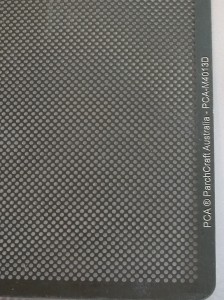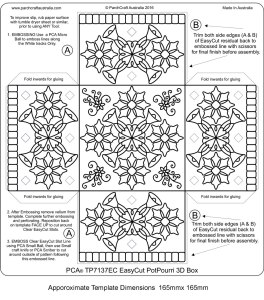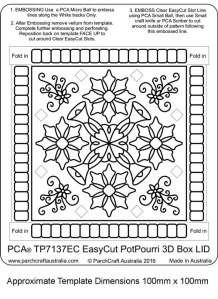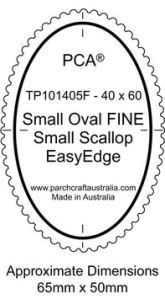History of Grids
The original Pergamano grids for parchment craft were ‘wire mesh’ enclosed within a plastic frame. They are still available second hand – they were discontinued in favour of the metal Multi Grids some years ago. There are still some tools associated with the mesh grid available: the ‘Diamond’ perforating tool and ‘Triangle’ perforating tool and also the ‘Arrow’ perforating tool. 
Pergamano Easy Grid
The Multi Grids are a series of stainless steel designer grids. They are mostly A5 in size (grid no 28 is A4 size).

Tools Required for Multi Grids
You can emboss and perforate using the grids. Use the Single needle tools for perforating and the Stainless Steel Fine Stylus and Extra Small Ball tool for embossing.
For Perforating – Single Needle Tool and Single Needle Bold
For Embossing – Pergamano Extra Small Ball 1mm and Fine Stylus 0.5mm
Most of the Multi Grids have designer patterns and themes for you to mix and match on your cards. These cards were made using Pergamano Multi Grid no 33 Butterfly Kisses and no 36 Summer Garden. There are four plain grids to use for making your own designs or making use of gridwork patterns from books, patterns or DVDs.
A Pergamano Diagonal Grid has holes offset at 60 degrees
Diagonal: No 19 – Bold
Diagonal No 24 – Fine
Straight Grid: No 4 – Fine
Straight Grid: No 28 – Bold

Tips for using Pergamano Multi -Grids
This method shows you how to emboss using the grid – and then perforate using the grid
- Attach parchment paper to the grid with removable magic tape or masking tape.
- Place the grid on an embossing mat and emboss where required. Pergamano recommend that the Stainless Steel ball tools are used on the Multi Grids: Fine Stylus 10032 and Extra Small Ball Tool 10072. If no embossing is required go to step 3.
- Turn the Multi-Grid over, with parchment still attached, change the mat to a deeper perforating mat and perforate the pattern using a single needle tool 10241.
- Remove the the parchment paper from the grid and using parchment scissors or Perga Cutters cut out the perforations where necessary.
If this method does not work for you take the parchment off the grid after embossing, turn it over so that the right side is facing you and carefully match the embossing pattern up so that your perforations will be in the right place. Fix the parchment down on the grid with tape, make sure you have changed to a perforating pad and perforate where required.
New to grids?
A Bold grid is easier to use if you are a beginner -you will need a bold perforating needle as well.
Can I use Pergamano tools with PCA grids?
No, the needles don’t fit very well. It’s best to stick to the tools that match the grids. The Pergamano single needle works well in the Siesta grids and Groovi grids.
PCA grids are all A4 size and made of a flexible steel –
PCA BOLD STRAIGHT PCA FINE STRAIGHT
As well as the Straight grid, PCA make a Diagonal Grid the holes on this grid are offset at 90 degrees – same as the straight grid.
PCA BOLD DIAGONAL PCA FINE DIAGONAL
Tools required for PCA FlexiDuo Grids
For perforating use PCA Unifine tool, and Unibold tools in the PCA Fine and Bold grids
Once you start perforating the parchment is fixed to the grid and won’t move. You can also use the PCA twin, quad, oct tools and
many more on the grids
For embossing use Small ball on the Bold grids and Micro Ball on the Fine grids
Tips for using PCA grids
This is the order to place the mat grid and paper ( bottom to top)
*****************************************
Perforate with either a Unibold or a Unifine according to your grid and pattern.
Fourth: Place the parchment paper on the grid ‘right side up’
Third: Place the FlexiDuo Grid on the top
Second: Place a tumble drier cloth on the perforating mat (optional) Tip – the tumble drier cloth lubricates the perforating tools so they don’t ‘stick’
First: Place an A4 perforating mat on the table.
******************************************
Make a little sample (one pattern repeat) of your design on scrap parchment, then you can use the perforated sample to, perforate or check the holes are in the right places as you move through the pattern.
Embossing Dots on a PCA grid
- If your pattern requires embossing and perforating it is usually best to emboss before you do perforations, but follow your pattern instructions for best results. The parchment paper should be ‘front side down’ if you are embossing dots.
- Use an embossing ball tool slightly larger than the holes in the grid. (small ball for bold, micro ball for fine)
- You can emboss dots with the grid on a hard surface (no mat)


Siesta Designer Grids, Medium Grids and Small and Large Grids and Ruler Grids are also made from steel. Most of the small and large grids come with a free perforating mat. The Ruler Grids come in a range of designs for making easy borders. The designer grids enable you to decorate parchment paper with motifs, borders, frames, corner embellishments and more. The Medium Grids have a range of flower motifs and patterns for a fan.
:

The plastic regular grids are also in either straight or diagonal similar to the Pergamano grids.


A4 size grid in Straight and Diagonal types (above) – there are also smaller plastic grids available 148mm x 148mm (below) in both straight and diagonal






Just follow the pattern on the plastic border plate grid.


Tina Cox’s small guide books for Groovi Piercing Border Plates.
More Help

Grid and Lace Work DVD is an excellent instructional DVD by Christine Coleman -learn how to use PCA grids while completing several projects.

Best of the Best 2 GridWork by Kannikar Sukseree – a collection of gridwork designs to use in your projects







































































































